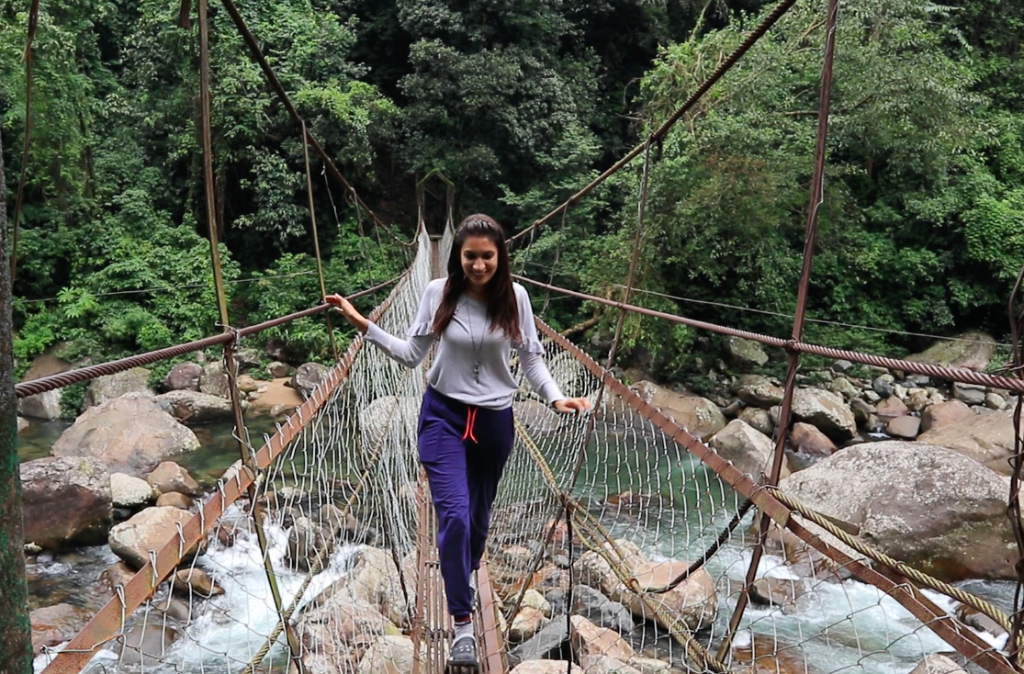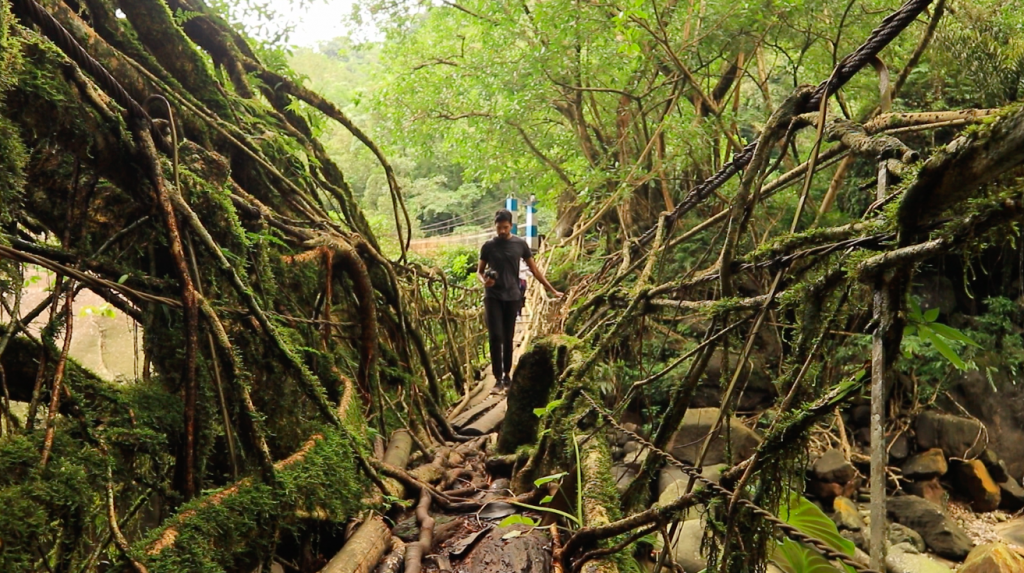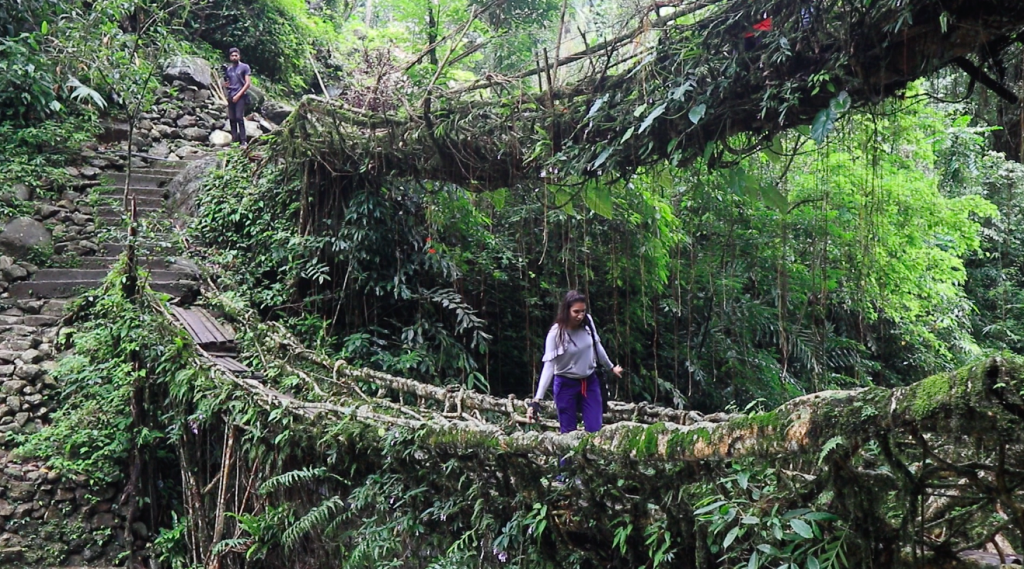Nongriat and the living root bridges of Meghalaya are a place like no other. So unique, raw and deep into nature. Seeing the wonderful double-decker bridges here left me in clear admiration of the people, their effort, and natures’ beauty. Nongriat and the neighbouring village of Tyrna are both associated with the bridges and are located near the town of Cherrapunji.
Located in the East Khasi Hills in north-eastern India, these bridges are one of a kind. The village has three functional root bridges, and one of the most impressive bridges is called Jingkieng Nongriat.
What are the living root bridges?
These bridges were created by the local Khasi people, who have been weaving the aerial roots of banyan trees on opposite sides of streams and gorges for centuries, by hand. It is said that the older the roots are, the stronger they get. They are known as living because their roots keep growing.

To reach here, you have to climb down 3,000 steps and reach a village called Nongriat. It is completely worth the effort – not just to see such a unique creation, but to experience how the villagers and locals live away from the modernization.
What’s the best time to visit?
The weather in Meghalaya is very unpredictable. It is said to receive the world’s heaviest rainfall recorded every year, due to which monsoon is usually best avoided! However, the trek is open throughout the year.
The best time to do it is said to be in the summer, as in the monsoon season, the path becomes very slippery and at times the rainfall is so heavy that you won’t be able to walk ahead. However, I have visited the double-decker living root bridges twice, both during the monsoon season. Luckily it wasn’t raining when I went here.
How to Reach Double Decker Living Root Bridges

Public transportation in Meghalaya is very limited. To reach the closest points to Nongriat, it is best that you either hire a motorbike or take a taxi from Shillong’s Police Bazar. Your first stop would be a small village called Tyrna from where the hike to Nongriat starts.
If you are coming via your own vehicle there is a parking spot to park your vehicle, depending on the number of days you are staying in Nongriat. It is completely safe to park the vehicle here. After reaching Tyrna’s parking lot you will see a signboard that leads to Nongriat village. Take the staircase downwards that leads directly to root bridges.
Where to Stay?
In Cherrapunji
There are several options to spend the night in Cherrapunji for you to choose from. However, I would like to specifically highlight the “By the Way Guesthouse”. It offers both – private room and hostel facilities for just INR 500. In fact, the owner will help you with planning your trip and suggest a few places as well.
In Tyrna
Here, I stayed at “Serene Homestay” which charges INR 300 per person, for a room and a common washroom (with hot water). They also have private double rooms for INR 800. Another option is “Santina’s Homestay” which starts at INR 250 per person.
Do you need a guide to visit the root bridges?

It is very easy to reach the root bridges of Nongriat without a guide. The trail is well laid out, and all you have to do is follow the stairs. You will also cross two suspension bridges before reaching the closest village. Once you reach the parking area near Tyrna, there will be many locals who would try to convince you to take a guide. But be firm and say a no. You can easily complete this trek on your own.
Entry Charges
The entry charges for visitors is INR 20. Professional video cameras are charged an extra INR 1000, and normal cameras only INR 20.
A checklist of things to carry to the root bridges
- Water Bottle – it is very important to carry water with you while trekking. Carry a good bottle with you, so that, instead of purchasing plastic water bottles, you can easily refill your own. The water is super clean and fresh.
- Spare Clothes – After reaching the double-decker living root bridges, there is no way that you won’t want to take a dip in the river below. So, carry spare clothes with you to change into. There is a proper washroom where you can change as well.
- Money – Carry extra cash with you because you’ll need it for various purchases along the way, such as the entry charges, and food.
- Hiking Shoes – The walk to the double-decker living root bridges is long and you will cross several uneven paths. Having a good pair of shoes is an absolute must.
- Bug Spray – You will be walking in the jungle and will encounter loads of bugs. Be prepared for it.
- Rain cover/Poncho – If you are travelling here during the monsoon season ensure that you are carrying a rain cover to prevent yourself from getting drenched.
- Snacks – Bring energy giving products such as fruits, energy bars. It is very easy to get tired and drained out.
Also Read: A Detailed Guide to Mawryngkhang Trek
Nongriat and the living root bridges of Meghalaya are a very unique place. Reaching here is a little challenging but once you get there and see the roots and take a dip it all becomes worth it. Do explore this place if you are planning to visit Meghalaya. It is one of the best places the state has to offer.


